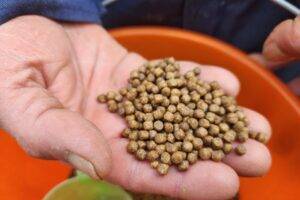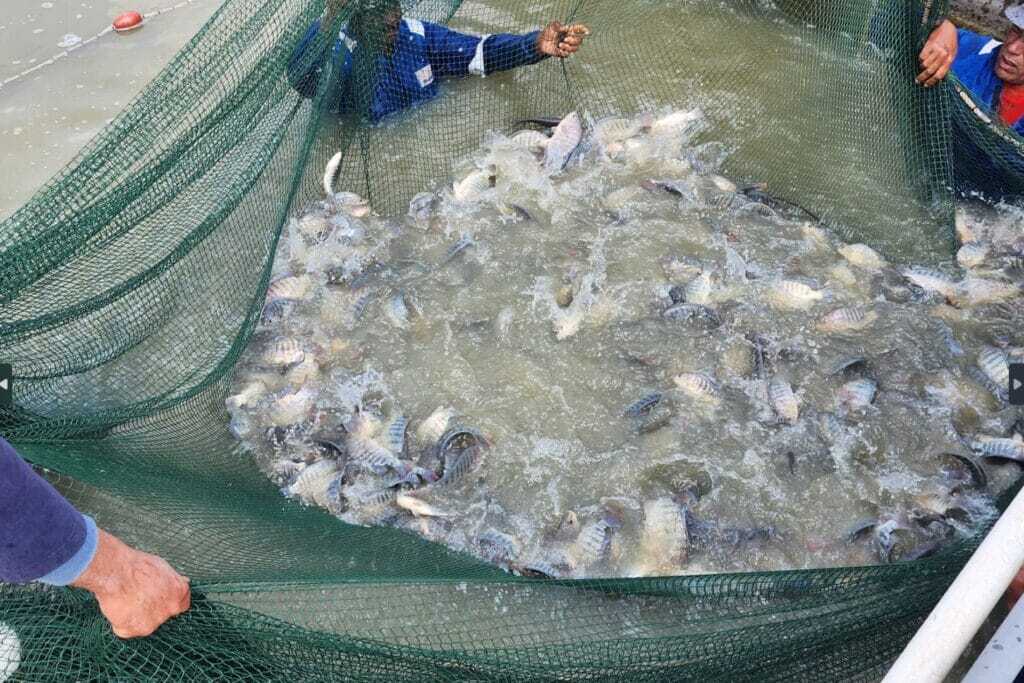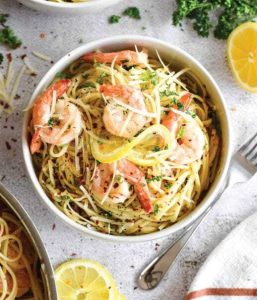Guest Blog by Aaron Putze, Iowa Soybean Association
When soybean farmers say their “real” customers are pigs, they truly mean it.
That reference to the importance of swine rations in driving demand for soy, however, is in no way a slight to other important markets.
That includes those with fins, scales and gills.
As developing countries strive to feed their growing populations more protein, fish is increasingly on the menu . . . and not just species harvested from streams, rivers and oceans.
According to the Food and Agriculture Organization, global average consumption of fish and other seafood reached a record high of 20.5 kilograms per person in 2019. That amount is expected to increase as the quality and affordability of fish improves.
Enter Iowa and U.S. soybean farmers.
To meet the growing demand and taste for quality, farm-raised fish, professional feed using ingredients other than fishmeal and fish oil are coming into vogue. Soy is the most-used protein source in aquafeeds worldwide. According to the Global Seafood Alliance, soybean meal, soy protein concentrates, and soybean oil are increasingly go-to feed ingredients required for many farmed species.

Research funded by soybean farmers has played a key role in developing this win-win demand driver. More appetite for sustainably produced and healthy fish is a boon to soybean demand.
In addition to developing soy-based feeds ideally suited for hungry fish and shrimp, soybean farmers have also played a key role in developing new ways to produce farm-raised fish. They are advancing educational activities carried out by the U.S. Soybean Export Council (USSEC) to train people in developing countries on how to manufacture professional feed using soy.
Iowa soybean farmers take great pride in the role they’ve played in developing better methods and feed for producing fish.
But the story doesn’t end there.
Soy Excellence Centers (SECs) were launched by USSEC in 2019. They offer professional training in a variety of curriculums including feed milling, soybean processing and refining and poultry, dairy, swine and fish production.
More than 6,500 trainees have participated in SECs. One such center operates in Egypt – a facility I was able to see firsthand during a trade mission to the country of 110 million earlier this year. Better training, fish feed and production methods have had a profound impact. The metric tonnage of farm-raised fish production has increased from 600,000 in 2005 to nearly 1.5 million in 2019. Production is projected to surpass 2 million metric tons by 2030.

Farm-raised fish account for almost 80% of Egypt’s seafood market, up from 50% in 2012. Tilapia is the choice of 80% of Egyptians. Other fish species include catfish, sea bass, mullet and carp. Shrimp production is gaining in popularity as farmers seek to diversify and capture greater premiums and profits.

Give the people of a country a fish, and they’ll eat for a day. Teach them how to produce fish (and poultry and milk), and they’ll eat for a lifetime.
That’s the power of soy and Iowa’s soybean farmers.
Aaron serves as Chief Officer of Strategy and Brand Management for Iowa Soybean Association. You can reach Aaron at 515-975-4168 or aputze@iasoybeans.com.
All this talk of fish made us hungry for a yummy Friday recipe! Check out this Lemony Shrimp Scampi Linguine from The Iowa Food and Family Project.
Lemony Shrimp Scampi Linguine

Ingredients
- 1 pound linguine pasta
- 4 tablespoons olive oil, divided
- ½ teaspoon garlic salt
- ¾ cup chopped fresh parsley leaves, divided
- 3 tablespoons butter
- 6 cloves garlic, minced
- 1 teaspoon salt
- ¼ teaspoon freshly cracked
- black pepper
- 2 pounds large shrimp
- Zest and juice of one lemon
- ½ cup chopped fresh parsley leaves
- ¼ teaspoon crushed red pepper flakes (use ½ teaspoon if additional
spice is desired)
GARNISH
- Freshly grated parmesan cheese
- Chopped fresh parsley leaves
- Lemon slices
Directions
Prepare pasta in boiling water and cook until al dente, around 1 minute less than package instructions indicate.
Drain and toss with 1 tablespoon of olive oil, sprinkle with garlic salt and ¼ cup of fresh parsley and set aside.
In a large skillet, over medium-low heat, melt the butter and remaining olive oil. Add the garlic, salt and pepper and sauté for 1 minute.
Add shrimp and cook for approximately 5 minutes, stirring occasionally until shrimp are cooked throughout and pink in color.
Remove from heat and add lemon zest, lemon juice, parsley and crushed red pepper flakes. Stir to combine.
Add pasta to skillet and toss together to coat pasta.
Serve immediately with freshly grated parmesan cheese and salt and pepper to taste.
Garnish dish with thinly sliced lemon and chopped parsley.
Recipe and photo courtesy of Iowa Food and Family Project.
